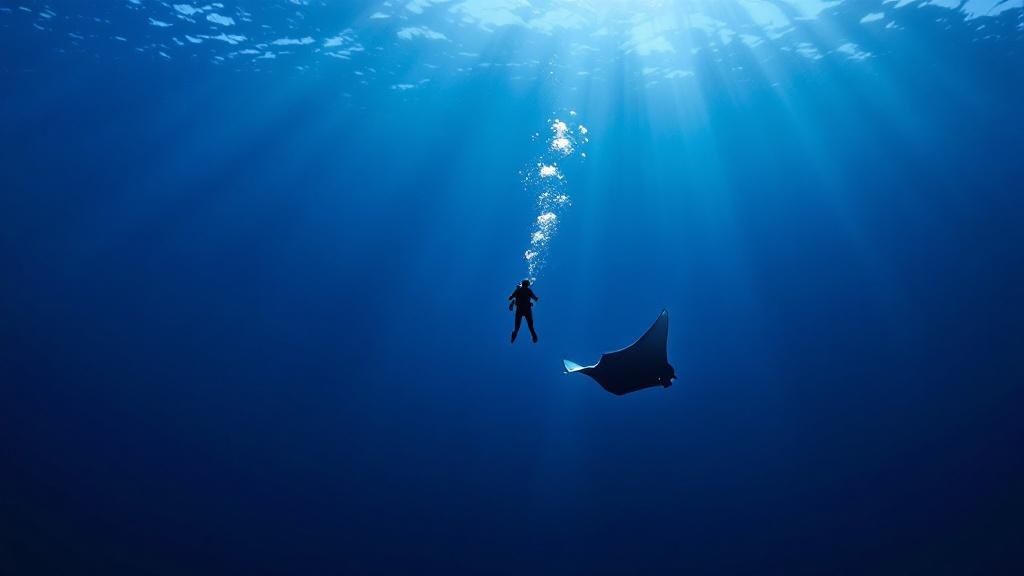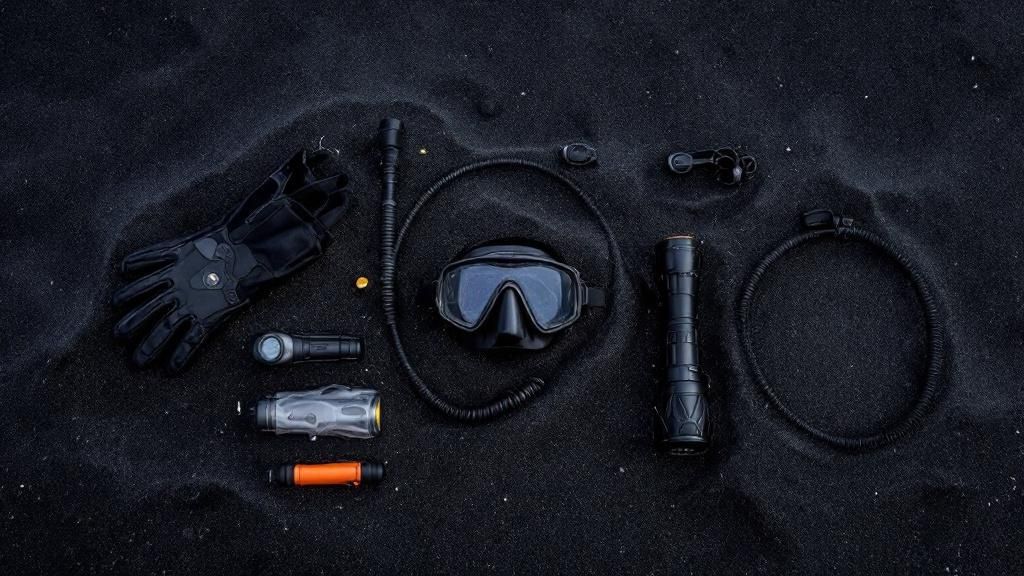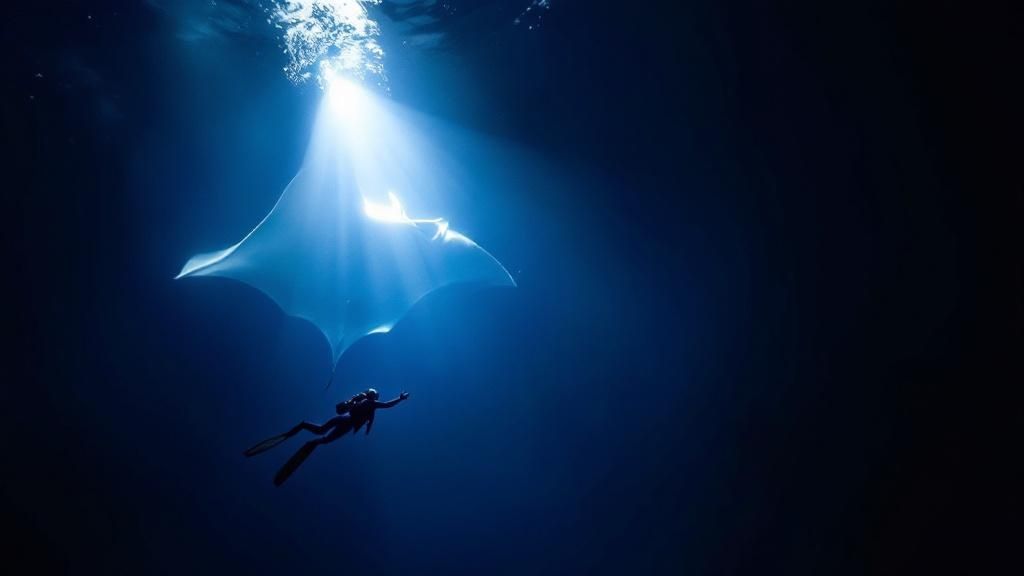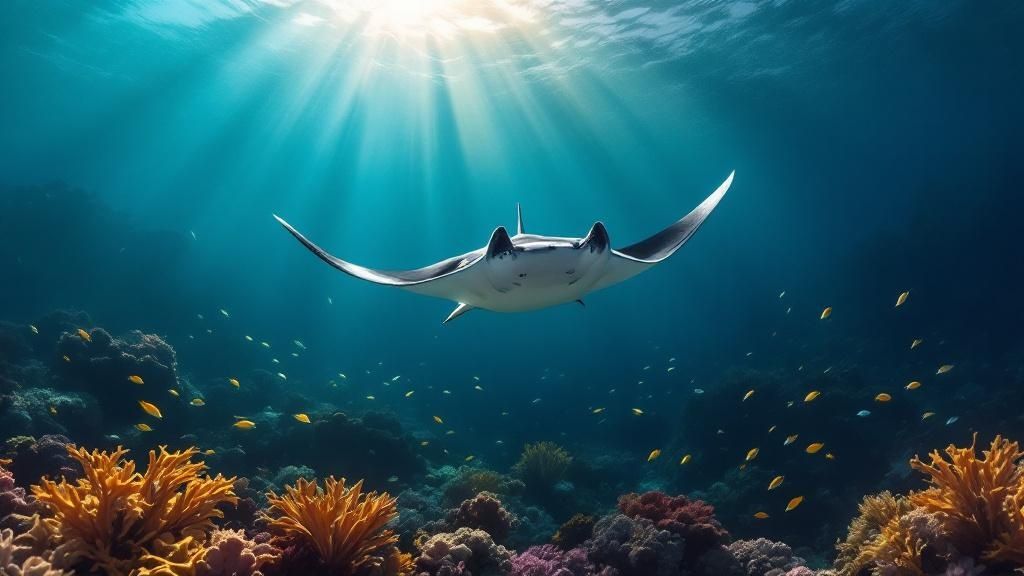Imagine floating in the warm, dark Pacific while giant, gentle shadows glide through illuminated water—this is the magic of the manta ray dive in Kona. It’s so much more than just a dive; it's a front-row seat to a silent, mesmerizing ballet that you’ll remember for the rest of your life.
Your Guide to an Unforgettable Manta Ray Encounter

Kona isn't just a great spot for seeing manta rays; it’s hands down the best and most reliable place on the entire planet for this specific adventure. While other destinations might offer seasonal or hit-or-miss sightings, Kona’s resident manta population shows up to feed at designated sites almost every single night.
This guide goes beyond the glossy brochures. We'll break down exactly what makes Kona the world's premier destination for this bucket-list encounter and give you the insider knowledge you need to plan the perfect trip. We’re covering everything from choosing the right operator to what to do in the water.
Why This Dive is So Special
So, what’s the secret behind Kona’s incredible consistency? It’s a beautifully simple relationship between light, plankton, and mantas.
Dive operators figured out that shining powerful lights into the water attracts dense clouds of phytoplankton, which is the manta rays' favorite meal. The mantas, being incredibly smart animals, quickly learned where to find a reliable, all-you-can-eat buffet. They show up night after night to feast, gliding gracefully through the light beams right in front of you.
This incredible reliability has turned the dive into a cornerstone of the Big Island’s tourism. Each year, around 80,000 people come to experience the manta ray tours, making it a vital part of the local economy.
The experience is often described as an "underwater campfire." Divers gather in a circle on the sandy bottom, lights pointing up, and simply watch the majestic show unfold above them. It's a peaceful, stationary dive where observation is the only goal.
To get a real sense of the experience, check out this in-depth article on the Manta Ray Dive Kona: An Epic Hawaiian Adventure.
For a firsthand account of the entire process from start to finish, you can also read about what it's like to go on the manta ray dive in Kona. This guide will give you the tools to plan your own perfect encounter.
Choosing the Right Kona Manta Ray Dive Operator

Let's be real—picking the company for your manta ray dive in Kona is the single most important call you'll make. This isn't just about finding a boat to get you from point A to point B. The operator you choose shapes the entire experience, from your safety and comfort in the water to the magic of the manta encounter itself.
It’s tempting to just sort by price, but I’m telling you, that’s a mistake. The real goal is finding the best value and an operator who genuinely respects the mantas and the ocean.
Large Boat vs. Small Charter
Right off the bat, you've got a fundamental choice to make: go with a big, spacious boat or opt for a smaller, more intimate charter. There’s no right or wrong answer here; it’s all about the kind of night you want to have.
Large boats have their perks. They often come with more amenities—think onboard restrooms, roomy decks for gearing up, and sometimes even a warm shower post-dive. That stability is also a huge plus if you’re worried about seasickness. The trade-off? More people. A bigger boat means a bigger group in the water, which can occasionally feel a bit crowded at the manta "campfire."
On the other hand, small charters (often called "six-packs" because they typically take six or fewer divers) offer a completely different vibe. It’s a much more personal adventure. You get more direct attention from your guide, and the smaller group size often makes for a calmer, more reverent experience with the mantas. The flip side is you might give up some creature comforts and the ride out can feel a bit bumpier.
Here’s a quick comparison to help you figure out what's best for you.
Kona Dive Operator Comparison Guide
When you're weighing your options, think about what matters most for your perfect dive. This table breaks down the typical differences between the two main types of operators.
| Factor | Large Boat Operator | Small Charter Operator |
|---|---|---|
| Atmosphere | Social, energetic, more people | Intimate, quiet, personalized |
| Amenities | Often has restrooms, showers, more space | Basic amenities, less deck space |
| Group Size | 20-40+ passengers | 6 or fewer passengers (a "six-pack") |
| Guide Ratio | Higher diver-to-guide ratio | Excellent diver-to-guide ratio |
| Ride Comfort | More stable in choppy water | Can be a bumpier ride |
| Best For | Social divers, those wanting amenities | Photographers, new divers, quiet observers |
Ultimately, it comes down to matching the boat to your personality. If you’re a brand-new diver needing a little extra hand-holding or a photographer who wants elbow room for the perfect shot, a small charter is probably your best bet. But if you value stability and having an on-board head, a larger vessel might be the way to go.
Look for the Green Seal of Approval
No matter the size of the boat, the best operators are all committed to one thing: running a safe and sustainable tour. The most critical credential to look for is their certification as a Manta Ray Green List Operator.
This isn't just some marketing gimmick. This official designation is given only to companies that stick to strict, science-backed standards for responsible manta ray viewing. They follow specific rules about lighting, positioning, and passive observation to make sure the mantas are protected. Choosing a Green List company means your money is directly supporting the conservation of these incredible animals.
You can check out some of the top-rated Kona manta ray night snorkel tours to get a feel for which operators are meeting these high standards.
One last piece of advice: ask questions before you book. A good, reputable company will be totally transparent.
- What’s your safety record?
- How experienced are your divemasters?
- What happens if the mantas don't show up?
Most quality outfits have a "manta guarantee," meaning you can come back another night for free if the stars (and plankton) don't align. Digging into our list of the top 5 manta ray night dive tours is another great way to vet your options and find the perfect fit.
Finding the Best Time and Place to Dive

When it comes to planning the perfect manta ray dive in Kona, timing is everything. The good news? You can see mantas here pretty much any day of the year. But your experience can feel worlds apart depending on the season you visit and, more importantly, the dive site you choose.
Getting this right is what separates a good dive from a truly unforgettable one.
The popular peak season runs from April through October, and for good reason—the water is warmer and the weather tends to be more reliable. That said, don't write off the "off-season." Visiting between November and March often means smaller crowds, both on the boat and in the water. This can make for a much more intimate and relaxed encounter with the mantas. For a deeper dive into the seasonal specifics, you can check out our guide on what is the best time of year to see manta rays in Kona.
Manta Village vs. Manta Heaven
Beyond just picking a month, your most critical decision will be choosing between the two main dive sites: Manta Village and Manta Heaven. Each spot offers a distinct flavor of the manta experience, and knowing the difference is key.
This isn't just local folklore; the behavior of these animals has been studied extensively. From 2009 to 2014, researchers tracked individual mantas along the Kona Coast, confirming their movements and site fidelity between these two locations. This work gave us solid data on how these resident populations live and feed in their home turf.
Manta Village: The Reliable Favorite
Located just south of Kailua-Kona near Keauhou Bay, Manta Village (also known as Kaukalaelae Point) is the go-to spot for most operators. It's earned its reputation through sheer consistency and accessibility.
- Shallow and Calm: The site sits in a protected bay with a sandy bottom at a comfortable 25 to 35 feet. These calm, shallow conditions make it absolutely perfect for first-timers or anyone feeling a bit nervous about night diving.
- High Success Rate: Because it's so sheltered, trips to Manta Village are rarely canceled due to rough seas. More importantly, the manta sightings are incredibly reliable.
Think of Manta Village as the gold standard for an introduction to the manta dive. If you're a new diver, bringing the family, or just want the highest probability of a smooth, successful night, this is your spot.
Manta Heaven: For a Different Perspective
Head a bit further north, closer to the Kona airport, and you’ll find Manta Heaven (or Kohanaiki). This site presents a slightly different profile that really appeals to seasoned divers and especially underwater photographers.
Manta Heaven is deeper, with the main viewing area sitting around 40 to 50 feet. The extra depth sometimes changes the mantas' behavior and gives photographers unique angles to shoot from—without a bunch of snorkel fins kicking overhead.
The experience here is just as spectacular, but the conditions can be a bit more of a wildcard. The site is more exposed to the open ocean, making it more susceptible to swells and the occasional cancellation. On a calm night, though, the deeper, darker setting provides a dramatic, cinematic backdrop for the manta ballet. It’s a fantastic choice for repeat visitors looking for a fresh take on Kona's signature dive.
How to Prepare for Your Kona Manta Dive
A little bit of prep work goes a long way to making sure your manta ray dive in Kona is the incredible, life-changing experience it should be. It’s nothing complicated, but sorting out a few key details before you even head to the harbor will make everything smoother, safer, and a whole lot more comfortable.
First things first, let's talk simple logistics. Do yourself a huge favor and wear your swimsuit under your street clothes to the boat. It’s a classic diver trick for a reason—it saves you from the awkward shuffle of changing in a cramped boat head (bathroom) and gets you into your gear and ready to go in a snap.
Just as important is thinking about what happens after the dive. The water in Hawaii feels amazing, but the boat ride back to the marina at night can get surprisingly chilly once the sun is down and the wind picks up. Always, always bring a warm, dry jacket or hoodie and a towel. Trust me, you’ll be glad you have something cozy to pull on for the ride home.
Gearing Up for the Dive
Now, let's get into the gear. Most reputable dive operators in Kona have top-notch, well-maintained rental equipment, so there's absolutely no shame in renting. It’s a fantastic option. That said, if there's one piece of gear that can make or break your dive, it's your mask.
There is nothing worse than a leaky, constantly fogging mask when you're trying to have a zen-like experience with giant, graceful mantas. It's a massive distraction. If you have your own mask that you know fits your face perfectly, bring it. If you're renting, take a few extra minutes at the shop to get a proper fit—make sure it seals comfortably against your face without having to crank down the strap.
For a complete look at all the gear that will make your trip a success, check out our guide on the gear you will need for your Kona diving adventure.
Getting Mentally Ready for the Experience
Physical prep is one thing, but getting your head in the game is just as crucial, especially if this is your first night dive. Just knowing the flow of the dive can wash away any pre-dive jitters and let you relax into the moment.
We often call this dive an "underwater campfire," and when you see the setup, you'll understand why. Here’s a quick rundown of what to expect:
- The Descent: Your group will descend together to a specific spot on the sandy ocean floor, typically somewhere between 25 and 40 feet deep.
- The Setup: Once on the bottom, divers get into position, either in a circle or a line. You'll usually be kneeling or lying flat on the sand, finding a comfortable spot.
- The Lights: A big, powerful light box—"the campfire"—is placed in the middle of the group. Its bright beams shine straight up toward the surface, attracting the plankton that mantas love to eat.
- The Show: From here, your job is simple: stay still, breathe easy, and watch the show. The mantas will swoop, soar, and glide right over your head, feeding on the plankton concentrated in the light.
The most important skill you'll use on this dive isn't swimming—it's staying completely still with excellent buoyancy control. Practice hovering neutrally. The whole point is to become part of the underwater landscape, letting the mantas feel comfortable enough to put on their natural show.
When you prepare for both the practical and mental sides of the dive, you’re setting yourself up for an effortless, mesmerizing encounter. You get to push all the distractions aside and be fully present for one of the most magnificent wildlife displays on the planet.
Practicing Safe and Responsible Manta Interaction

Encountering these gentle giants on a manta ray dive in Kona is an absolute privilege. But with that privilege comes a serious responsibility to protect them. The entire experience is built on a foundation of respect, which is exactly why Kona has become a global model for sustainable marine ecotourism.
Understanding the rules isn't just about safety checklists; it's about ensuring these magnificent creatures continue to thrive for generations.
The core principle is simple: passive observation. You're a guest in their world. Your job is to become part of the underwater scenery so the mantas feel comfortable enough to go about their natural feeding behavior right in front of you.
The Unbreakable Rule: Never Touch a Manta
If you only remember one thing from your dive briefing, make it this: you must never, ever touch a manta ray. This isn't just a suggestion; it's the most critical rule of the entire dive.
Why? Mantas have a special protective mucus layer covering their skin. Think of it as their shield against harmful bacteria and parasites in the ocean.
Touching them, even with a gentle, accidental brush of your hand, can rub off this vital coating. This leaves them vulnerable to nasty skin infections and diseases that can cause serious, lasting harm. A single thoughtless touch can have devastating consequences for a manta's health.
This hands-off policy is the cornerstone of the entire Kona manta ray dive industry. It’s what makes these close, consistent, and safe encounters possible, year after year. Respecting their space is, quite literally, respecting their life.
Following this one rule is fundamental to being part of this incredible adventure. You can learn more about why you should go on a manta ray dive in Kona and see how this responsible approach defines the entire experience.
Following Manta Tour Operator Standards
To make sure everyone is on the same page, Kona’s dive community came together to establish the Manta Tour Operator Standards. Every reputable operator follows these rules to minimize our impact. Your divemaster will go over them in detail, but here are the key things to know before you even get on the boat.
- Stay on the Bottom: As a diver, you'll need to stay put on the sandy bottom, either kneeling or lying down. This creates a stable, predictable environment for the mantas and keeps you from accidentally floating up into their path.
- No Chasing: Never swim after or pursue a manta ray. Let them control the encounter. Chasing a manta will only scare it off and ruin the show for everyone.
- Watch Your Bubbles: Try to time your breathing so you aren’t exhaling a huge cloud of bubbles right into a manta’s face as it glides overhead. It won't hurt them, but it can be startling and cause them to change course.
This commitment to conservation goes way beyond just the dive boats. The manta ray dive industry in Kona is a powerful force for local conservation, and it’s backed by strong state-level protections. In fact, on June 5, 2009, Hawaii made it illegal to kill or capture manta rays in state waters, a huge step in safeguarding the local population.
Considering Hawaii is home to 85% of all U.S. coral reefs, these sustainable practices are vital for both the mantas and the entire marine ecosystem.
By choosing a responsible operator and following these simple rules, you become an active participant in one of the world's greatest conservation success stories.
Answering Your Kona Manta Dive Questions
Even after doing all the planning, it's totally normal to have a few last-minute questions buzzing around your head before a big dive like this. Getting them answered is the best way to quiet those nerves and make sure you feel 100% ready to hit the water for this world-famous encounter.
Think of this as your final check-in for all those "what if" thoughts.
Do I Need to Be an Experienced Diver for This?
Absolutely not. This is one of the best things about the Kona manta ray dive—it’s famously accessible, making it an incredible experience even if you’re fresh off your open-water certification.
Most operators run this dive at a spot called "Manta Village," which is well-protected, calm, and has a shallow sandy bottom at around 25 to 35 feet. You'll spend most of the time kneeling or lying still, so there's no tricky navigation or hard swimming. Your only job is to be a quiet observer. In fact, many people do this as one of their very first night dives! Just let your dive crew know your experience level when you book, and they'll take great care of you.
Is Snorkeling as Good as Diving with the Mantas?
The snorkeling experience is genuinely amazing and a fantastic option if you're not a certified diver or have non-divers in your group. It’s not a "lesser" experience at all, just a different one.
Snorkelers hang onto a big, custom-built floatation board that has powerful lights pointing down. These lights attract the plankton right up to the surface, and the mantas are hot on their trail. You get this unbelievable top-down view of these massive, elegant creatures barrel-rolling and feeding just inches beneath you. Honestly, you're often just as close to the action as the divers below.
It really comes down to your preference and certification. Do you want to watch the ballet from the "balcony" (snorkeling) or from the "front-row floor seats" (diving)? You can't go wrong either way.
What Happens If We Don’t See Any Mantas?
It's a fair question. While Kona has an insanely high success rate—most operators will tell you it's over 90%—these are wild animals in their natural home. Sightings are never a 100% guarantee. That’s the beauty and unpredictability of nature.
This is exactly why choosing a reputable operator is so important. Before you book, always ask about their "manta guarantee" or no-show policy. Most of the established companies will offer you a second chance to come back on another night, either for free or for a steep discount (subject to availability). This policy shows their confidence in the dive and their commitment to making sure you have an incredible time.
Will I Get Cold and What Wetsuit Should I Wear?
Kona's water is wonderfully warm, usually somewhere between 75-80°F (24-27°C). But, and this is a big but, you’ll be sitting pretty still for about 45 minutes at night. That can cause your body temperature to drop, even in tropical waters. Getting a chill is a real possibility.
Your dive shop will almost always provide a full-length wetsuit, typically a 3mm or maybe a 5mm, which is fine for most people. However, if you're someone who gets cold easily (you know who you are!), it’s smart to bring a little extra something.
Think about wearing a thin rash guard under your wetsuit or even packing a neoprene hood or vest. Being even a little bit cold is a huge distraction from the main event. It's always better to be a bit too warm than to spend the whole dive shivering and wishing it was over.
Are you ready to witness the underwater ballet for yourself? The expert crew at Kona Honu Divers is here to make your manta ray dive safe, comfortable, and absolutely unforgettable. Book your adventure today at https://konahonudivers.com and join our ohana for the experience of a lifetime.
